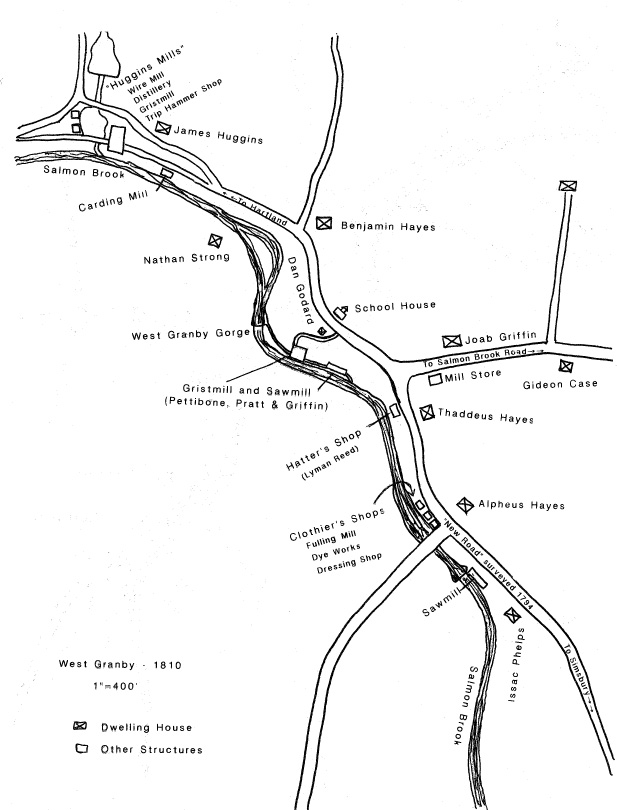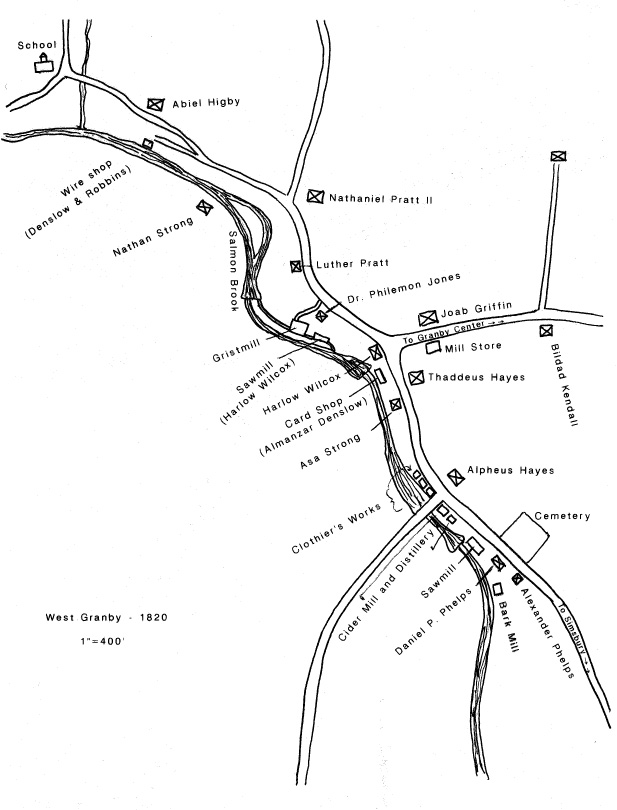Adapted from Connecticut Case Studies, by Mark Williams
TEACHER'S SNAPSHOT
Subjects:
Business & Industry, Early Republic, Economics, Environment, Geography, Invention & Technology, Work
Course Topics/Big Ideas:
Influence of Geography on the Social, Political, and Economic Development of CT Towns and the State, Role of Connecticut in U.S. History
Grade:
Grade 8
Lesson Plan Notes
Granby, Connecticut is approximately fifteen miles northwest of Hartford, on the edge of the Berkshire foothills. The town was originally part of Simsbury, which had two settlements, one at Hopmeadow (along the Farmington River) and another at Salmon Brook, an elevated meadow area between two branches of a tributary of the Farmington River, first settled in 1660. The settlers of Salmon Brook and other newly-settled areas of Simsbury complained that it was too difficult to attend church services and meetings in Hopmeadow, and in 1736 residents successfully petitioned the colonial legislature to set up separate “ecclesiastical societies,” or parishes, each with its own church. In October 1786, the two parishes of Salmon Brook and Turkey Hills became the town of Granby.
The process of industrialization was a central fact of life throughout 19th-century America. The story of Granby, Connecticut, though, was very different from that of the more-familiar Lowell, Massachusetts. In fact, the story of Granby is mostly a story of failure. By the end of the century, the town had become a sleepy farming area, the foundations of many of the shops along Salmon Brook all but hidden in the weeds. However, this failure actually makes the village an ideal illustration of the pervasiveness of urban and industrial culture in the early 19th century. It demonstrates how the roots of industrialization were just as present in small-town America as they were in the port towns and post-colonial cities. Furthermore, we can see that the advent of industrialization was not based simply in technological developments, but more broadly in individual ambition, increasing cosmopolitanism, and changing notions of status, to name just a few of the fundamental forces moving American society at the time.
ESSENTIAL QUESTION
SUPPORTING QUESTIONS
- How do historians find out about the lives of ordinary people in the past?
- What was life like in Granby, Connecticut in the early 1800s?
- How did industrialization change people’s lives in Granby?
- Why did industry thrive in some New England towns and not others?
ACTIVITY
1. Introduce the compelling question and the first supporting question and discuss what “evidence” students today might leave behind for historians of the future (Photographs? Birthday cards? School yearbooks? Diplomas/certificates? Special articles of clothing? School records/transcripts? Journals?) Discuss how the nature of historical evidence has already changed in the digital era (fewer handwritten letters, electronic communications, social media, photos born and kept only digitally, etc.)
2. Next, ask students to consider people living 200 years ago and what evidence historians can tap into to learn about their lives.
3. Explain that all of the sources the students will be examining relate to one Connecticut town and distribute/assign the sources in whatever way you feel will be most effective for your group (one source per individual/pair/small group, a few sources for each small group, or everyone looking at all of the sources.)
4. Students should look at each source and consider:
- What can they KNOW from each source? What information does the source provide and about whom?
- What can they GUESS or infer? Based on what?
- What does each source make them WONDER? What other kinds of sources might provide the additional information they seek?
5. Discuss how these documents can help students (and historians) develop answers to the supporting questions and ultimately the second compelling question. Discuss what gaps these documents leave in our knowledge and what types of evidence might be used to fill those gaps.
OPPORTUNITIES FOR ASSESSMENT
- Students will conduct research into one of the early 19th-century jobs/industries mentioned in the historic documents (e.g. farmer, blacksmith, peddler, carriage smith, physician, clockmaker, dentist, wheelwright, sawmill, musical instrument factory, tannery, etc.) and share their findings with the class in order to create a fuller picture of life in one New England town.
- Using the same or similar sources (U.S. Census, historic maps or newspapers, 1819 Gazetteer, etc.), students will examine the history of their own towns in the early 19th century and see what information they can glean about the lives of “ordinary” people.
- Students will create charts or info-graphics to effectively communicate some of the statistics provided in the historical sources.
RESOURCE TOOL KIT

Population Statistics, Granby, Connecticut, 1790-1860, compiled by Mark Williams.

Map of West Granby, 1810, compiled by Mark Williams.

Map of West Granby, 1820, compiled by Mark Williams.

Map of West Granby, 1845, compiled by Mark Williams.

A Gazetteer of the States of Connecticut and Rhode-Island, John Chauncey Pease, John Milton Niles, 1819, p. 76-80.
Internet Archive, Courtesy University of Michigan.

Excerpt from the 1820 U.S. Census, transcribed by Mark Williams.

Weekly News, Vol. 1, No. 4, March 18, 1840, Granby, Conn. Connecticut State Library.

Statistics of the Condition and Products of Certain Branches of Industry in Connecticut, Daniel P. Tyler, 1846, p. 23-24.
Hathi Trust, Courtesy Harvard University.

Three insurance policies from the 1840s. Salmon Brook Historical Society.

Excerpt from the 1850 U.S. Census, transcribed by Mark Williams.
ADDITIONAL RESOURCES
Places to GO
Things To DO
To see how the “pieces of history” can be woven together to tell a compelling story about a town and its people, read Williams, Mark. A Tempest in a Small Town: The Myth and Reality of Country Life – Granby, Connecticut 1680-1940. Granby: Salmon Brook Historical Society, 1996.
Websites to VISIT
Website of the Secretary of the State: Connecticut population data going back to the 1700s
“Granby – WPA Architectural Survey.” Connecticut State Library Digital Collections, 2013.
Articles to READ
ConnecticutHistory.org:
- “New England’s Grand Ambition: The Farmington Canal” by Richard DeLuca.
- “The Industrial Revolution Comes to Jewett City” by Laura Smith.
- “Ivory Cutting: The Rise and Decline of a Connecticut Industry” by Donald L. Malcarne and Brenda Milkofsky.
- “The Steady Evolution of a Connecticut Family Business” by Dawn Byron Hutchins.
Chapters on the history of Granby from Phelps, Noah A. History of Simsbury, Granby and Canton from 1642 to 1845. Hartford, CT: Case, Tiffany and Burnham, 1845.



